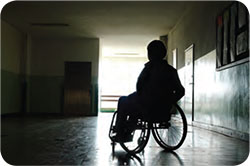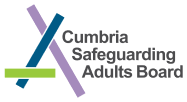What is Abuse and Neglect?
 Abuse and Neglect can happen anywhere including at home, in day care centre's or care homes and hospitals. It may happen once or take place over a longer period of time. Abuse can take different forms.
Abuse and Neglect can happen anywhere including at home, in day care centre's or care homes and hospitals. It may happen once or take place over a longer period of time. Abuse can take different forms.
Physical abuse: It could be being hit, smacked or restrained against their will. It might not be the physical act it could just be the threat of that. It can also include where people are using chemicals to force people into situations. It is anything that forcing somebody using external pressure on them.
Possible indicators of physical abuse:
- no explanation for injuries or inconsistency with the account of what happened
- injuries are inconsistent with the person's lifestyle
- bruising, cuts, welts, burns and / or marks on the body or loss of hair in clumps
- frequent injuries
- unexplained falls
- subdued or changed behaviour in the presence of a particular person
- signs of malnutrition
- failure to seek medical treatment or frequent changes of GP
Domestic abuse: Where one person living with another and one person is clearly abusing the other person. It could be in the form of physical, sexual or psychological abuse or any range of the other abuse. It is where someone is targeting someone else in their own household.
Possible indicators of domestic violence or abuse:
- low self-esteem
- feeling that the abuse is their fault when it is not
- physical evidence of violence such as bruising, cuts, broken bones
- verbal abuse and humiliation in front of others
- fear of outside intervention
- damage to home or property
- isolation - for example - not seeing friends and family
- limited access to money
Sexual abuse: this could be inappropriate touching, rape, forcing someone to watch pornography, indecent exposure, or where someone isn't able to consent to certain acts.
Possible indicators of sexual abuse:
- bruising, particularly to the thighs, buttocks and upper arms and marks on the neck
- torn, stained or bloody underclothing
- bleeding, pain or itching in the genital area
- unusual difficulty in walking or sitting
- foreign bodies in genital or rectal openings
- infections, unexplained genital discharge, or sexually transmitted diseases
- pregnancy in a woman who is unable to consent to sexual intercourse
- the uncharacteristic use of explicit sexual language or significant changes in sexual behaviour or attitude
- incontinence not related to any medical diagnosis
- self-harming
- poor concentration, withdrawal, sleep disturbance
- excessive fear/apprehension of, or withdrawal from, relationships
- fear of receiving help with personal care
- reluctance to be alone with a particular person
Emotional or psychological abuse: could be threats of harm, abandonments. Refusal to let people see their friends or family. Degrading people humiliating people, not letting someone have their opinion.
Possible indicators of psychological or emotional abuse:
- an air of silence when a particular person is present
- withdrawal or change in the psychological state of the person
- insomnia
- low self-esteem
- uncooperative and aggressive behaviour
- a change of appetite, weight loss or gain
- signs of distress - tearfulness, anger
- apparent false claims, by someone involved with the person, to attract unnecessary treatment
Financial and material abuse is when people have property stolen from them - that can be anything from money to a special toy that someone may use for comfort.
Possible indicators of financial or material abuse:
- missing personal possessions
- unexplained lack of money or inability to maintain lifestyle
- unexplained withdrawal of funds from accounts
- power of attorney or lasting power of attorney (LPA) being obtained after the person has ceased to have mental capacity
- failure to register an LPA after the person has ceased to have mental capacity to manage their finances, so that it appears that they are continuing to do so
- the person allocated to manage financial affairs is evasive or uncooperative
- the family or others show unusual interest in the assets of the person
- signs of financial hardship in cases where the person's financial affairs are being managed by a court appointed deputy, attorney or LPA
- recent changes in deeds or title to property
- rent arrears and eviction notices
- a lack of clear financial accounts held by a care home or service
- failure to provide receipts for shopping or other financial transactions carried out on behalf of the person
- disparity between the person's living conditions and their financial resources, e.g. insufficient food in the house
- unnecessary property repairs
Modern slavery - undertaking work for which there is no financial reward and whereby someone is not free to leave their conditions of work.
Possible indicators of modern slavery:
- signs of physical or emotional abuse
- appearing to be malnourished, unkempt or withdrawn
- isolation from the community, seeming under the control or influence of others
- living in dirty, cramped or overcrowded accommodation and or living and working at the same address
- lack of personal effects or identification documents
- always wearing the same clothes
- avoidance of eye contact, appearing frightened or hesitant to talk to strangers
- fear of law enforcers
This includes forms of harassment, slurs or similar treatment because of race, gender and gender identity, age, disability, sexual orientation or religion.
Possible indicators of discriminatory abuse:
- the person appears withdrawn and isolated
- expressions of anger, frustration, fear or anxiety
- the support on offer does not take account of the person's individual needs in terms of a protected characteristic
Organisational abuse is about poor practice within an organisation. It may be neglect, failure to meet needs or any kind of abuse. It is abuse that takes place within an organisational setting.
Possible indicators of organisational or institutional abuse:
- lack of flexibility and choice for people using the service
- inadequate staffing levels
- people being hungry or dehydrated
- poor standards of care
- lack of personal clothing and possessions and communal use of personal items
- lack of adequate procedures
- poor record-keeping and missing documents
- absence of visitors
- few social, recreational and educational activities
- public discussion of personal matters
- unnecessary exposure during bathing or using the toilet
- absence of individual care plans
- lack of management overview and support
Neglect is a failure to look after someone as you ought to be. Not giving them access to thigs they need such as food water, medicines, access to the toilet.
Possible indicators of neglect and acts of omission:
- poor environment - dirty or unhygienic
- poor physical condition and/or personal hygiene
- pressure sores or ulcers
- malnutrition or unexplained weight loss
- untreated injuries and medical problems
- inconsistent or reluctant contact with medical and social care organisations
- accumulation of untaken medication
- uncharacteristic failure to engage in social interaction
- inappropriate or inadequate clothing
This includes a wide range of behaviours, neglecting to care for one's personal hygiene, health or surroundings and includes behaviour such as hoarding.
This animation looks at the difficult topic of self neglect, how to recognise the warning signs and who you can contact for help. It is intended to raise awareness and to be used as a tool to start a conversation with someone you may be worried about:
What to do about self-neglect (Animation)
Cumbria Fire and Rescue Service Hoarding leaflet (PDF 7MB)
Self neglect: Can be someone deliberately harming themselves but also when someone starts to stop looking after themselves - like not washing or choosing to buy video games instead of food.
Possible indicators of self-neglect:
- very poor personal hygiene
- unkempt appearance
- lack of essential food, clothing or shelter
- malnutrition and/or dehydration
- living in squalid or unsanitary conditions
- neglecting household maintenance
- hoarding
- collecting a large number of animals in inappropriate conditions
- non-compliance with health or care services
- inability or unwillingness to take medication or treat illness or injury
